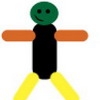Is Age of Empires II 3D or 2D?
If your signature on a web forum takes up more space than your average post, then you are doing things wrong.
Quote: Original post by Talroth
As far as I remember, it is all 100% 2D rendering of sprites in game. Sprites are generated from fairly high res 3D models during development.
That's right, here's a more detailed explanation: Postmortem: Ensemble Studios’ Age of Empires II: The Age of Kings.
It's isometric 2D graphics, and it's strictly a 2D game.
Now of course, I'm not sure if there is any 3D strategy game on the market at all... I believe they are all 2D games (even if some have 3D graphics).
Now of course, I'm not sure if there is any 3D strategy game on the market at all... I believe they are all 2D games (even if some have 3D graphics).
Homeworld would be an example of one with truly 3D gameplay mechanics. Heck, even X-COM had 3D gameplay, despite the isometric 2D graphics.
Though X-COM isn't a realtime strategy game, and Homeworld isn't exactly fast paced either. It's hard to create a sufficiently flexible user interface appropriate for high speed realtime play of a 3D strategy game when your input and output devices are all 2D. Maybe we just need a 3D holographic touch interface before fast paced 3D RTSes become a thing.
Although I love Homeworld and it clearly does have six degrees of freedom, it's still kinda not really fully 3D. The ships all orientate to the "ground" plane and a lot of the game play is based around it.
Although I love Homeworld and it clearly does have six degrees of freedom, it's still kinda not really fully 3D. The ships all orientate to the "ground" plane and a lot of the game play is based around it.
I can just image the amount of extra caos that would couse if there was no "up" direction
Never say Never, Because Never comes too soon. - ryan20fun
Disclaimer: Each post of mine is intended as an attempt of helping and/or bringing some meaningfull insight to the topic at hand. Due to my nature, my good intentions will not always be plainly visible. I apologise in advance and assure you I mean no harm and do not intend to insult anyone.
Homeworld would be an example of one with truly 3D gameplay mechanics. Heck, even X-COM had 3D gameplay, despite the isometric 2D graphics.Hmmm... maybe, but not quite, if you ask me.
X-Com lets you have units climb on a roof and such, granted. That's comparable with ramps and cliffs in most strategy games, but it's not truly 3D gameplay. Homeworld is truly 3D in its graphics and truly 3D in its gameplay, too... but the gameplay mostly looks 2D anyway (the ship formations are 2Dish too).
Plus, what's most important, in neither game, it really matters that the world is 3D. Starships can go just anywhere, you see something on the 2D map, click, and they go there and start shooting. It's actually closer to 1D (move forward, shoot) than to 3D.
For me, a truly 3D game would need to have mechanics where it really matters that you are in a 3D world. Yes, there are "cliff like" elements in a lot of games (like unit on roof in X-COM), but that is really just 2D with a barrier and with "portals" in between (ladders, ramps,...). Other than blocking other units, it does not really matter.
Take the battle of Crécy (which actually demonstrated 4D "gameplay") as a real world example. The English like to tell history the way that they are so superior and had their very superior longbow men which were that awesome, so they kicked butt. The truth is much closer to "the English were lucky that Philippe VI was one big dick and a really stupid one who knew nothing about war, or about the terrain".
Philippe chose a rainy day (causing failure in crossbows, and mighty bad for a low-cadence weapon that needs careful aiming) and led his forces who were mostly heavy crossbow men and heavy infantry uphill, leaving the cover for the crossbowmen in the camp (this unit is vulnerable, almost helpless while reloading!).
Shooting downhill gave the English a major range advantage (and impaired the uphill-going, uphill-shooting crossbowmen and uphill-going infantry). Also, for a longbow volley on a large group of hardly moving units, it does not matter a lot whether sight is good or bad (you will most probably hit something, anyway). That was failure to understand how a 3D world (or 4D if you take time/weather into account as well) works.
Now of course, that kind of thing would be super interesting in a strategy game. Imagine you have flying units, too (and not just 2D units that look like "flying", but ones that can drop bombs from far above and that you can't reach except if you too have a flying unit or a special anti-flying-unit weapon). When you shoot downhill, you suddenly have twice the range. When you march uphill, your units' stamina is depleted, and they are easier to hit. That is true 3D.
(For simplicity, I left out the part where Philippe ordered his cavalry to attack his own forces and where the English kept shooting and laughing at an enemy who was fighting their own kin. Did I mention that Philippe was a really stupid dick?)










